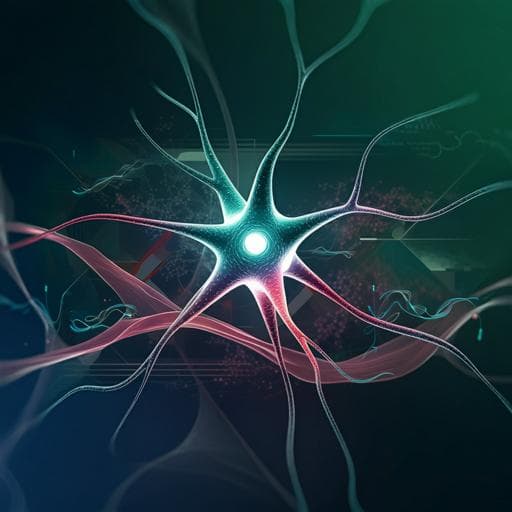
Health and Fitness
Acute changes in antioxidants and oxidative stress to vigorous arm exercise: an intervention trial in persons with spinal cord injury and healthy controls
M. F. Wouda, H. B. Steihaugell, et al.
Explore the intriguing findings of a study conducted by Matthijs F. Wouda and colleagues, which revealed how vigorous arm exercise impacts oxidative stress and antioxidant levels in individuals with chronic spinal cord injury compared to healthy controls. Discover the differences and similarities in their responses during and after exercise.
~3 min • Beginner • English
Introduction
Individuals with spinal cord injury (SCI) exhibit distinctive physiological changes including reduced lean body mass, increased adiposity, anabolic deficiency, endocrine dysfunction, osteoporosis risk, and elevated cardiovascular risk. Denervated muscle below the lesion undergoes mitochondrial impairment and a fiber-type shift toward fast glycolytic, contributing to fatigability and potential exercise-induced damage. Both physical inactivity and aging-related metabolic dysfunction are linked to impaired mitochondrial activity and increased reactive oxygen species (ROS) production, potentially elevating oxidative stress. Redox status reflects the balance between oxidants and antioxidants; excessive ROS, such as during exhaustive high-intensity exercise, can lead to oxidative stress and cellular damage. Prior evidence suggests SCI is associated with increased oxidative stress and reduced antioxidant defenses, especially in the acute and subacute phases post-injury, with some persistence over time. Given the importance of exercise for health after SCI, there is concern that high-intensity exercise could provoke unhealthy oxidative stress due to reduced antioxidant capacity. The study aimed to measure biomarkers of oxidative stress and antioxidant status at rest, during, and after a single bout of high-intensity arm-cranking exercise in persons with chronic SCI (>1 year postinjury), compared with matched able-bodied controls. The hypothesis was that individuals with chronic SCI would have lower antioxidant capacity and a different oxidative stress response to exercise than able-bodied individuals.
Literature Review
The introduction synthesizes literature indicating that SCI leads to muscle atrophy, increased intramuscular fat, mitochondrial dysfunction, and a shift to glycolytic muscle fibers, all of which can heighten oxidative stress. ROS production occurs during normal muscle contractions but can be excessive during exhaustive high-intensity exercise, potentially causing cellular damage. Immobilization itself can increase ROS. Endogenous antioxidants include enzymatic defenses (SOD, catalase, GPx), while exogenous antioxidants include vitamins E and C, thiols, polyphenols, and carotenoids. Prior studies reported reduced plasma antioxidants and increased oxidative stress biomarkers in SCI, particularly in the acute phase, with partial improvement but persistent deficits up to one year post-injury. Exercise guidelines exist for SCI but optimal intensity and potential oxidative stress risks with vigorous training remain unclear, highlighting a gap addressed by the present study.
Methodology
Study design: Intervention trial with matched able-bodied controls conducted at Sunnaas Rehabilitation Hospital, Norway (Feb 2016–Apr 2018). Participants: Six wheelchair-dependent adults with chronic SCI (>1 year post-injury), complete lesions (AIS A), thoracic levels T2–T8, intact upper limb function; age 18–70 years. Six healthy controls matched by age, sex, and BMI were recruited from hospital staff. Exclusions included medical conditions limiting exercise capacity. All participants obtained medical clearance.
Exercise protocol: Two lab visits separated by 1–3 days. Visit 1: Maximal arm-cranking test on an electrically braked ergometer (LODE). Five-minute warm-up at 20 W, cadence 60 rpm, then individualized workload increases (5–30 W) every 3 minutes until exhaustion. Continuous gas exchange (VO2, VCO2, RER, VE) measured (Vmax Encore 229D), and HR monitored (Polar M400). Peak HR and peak VO2 were defined as the highest 30 s average VO2 and highest HR achieved.
Visit 2: High-intensity interval exercise (HIT) consisting of alternating 3 minutes at low intensity (~40% HRmax) with 3 minutes at a predetermined constant workload targeting 85–95% HRmax, adjusted as needed to maintain intensity. Three high-intensity bouts were performed, followed by a brief rest and then a ramp to maximal effort to exhaustion. Participants abstained from alcohol, strenuous exercise, and food/tea for 1 hour before testing and until after the final blood draw, and returned 24 h later for follow-up sampling.
Sampling schedule: For Visit 2, blood samples were collected at baseline (pre-exercise), during high-intensity exercise (1–2 min after interval), at maximal effort, and at 5, 30, 60 minutes post-exercise, and at 24 h post-exercise. Urine was collected pre-exercise and 24 h post-exercise. Samples were aliquoted and stored at −20 °C, −80 °C, or liquid nitrogen as appropriate; vitamin C plasma aliquots were acidified with 10% metaphosphoric acid before −80 °C storage.
Biomarkers and assays: Plasma thiols and amino acids including total glutathione (tGSH), total cysteine (tCys), and total homocysteine (tHcy) were measured at all six time points using LC/MS/MS. Chromatography used a Phenomenex Kinetex C18 column (150×4.6 mm, 2.6 μm) with HFBA buffer and acetonitrile gradient at 0.8 mL/min, 30 °C, 1 μL injections with internal standards and validated calibration curves. Urinary oxidative stress biomarkers included 8-oxo-2′-deoxyguanosine (8-oxo-dG) and isoprostane 8-epi-PGF2α, measured by LC/MS/MS with SPE cleanup and internal standards; concentrations were normalized to urine creatinine (ng/g creatinine). Serum CRP, albumin, and creatinine were measured using standard clinical chemistry (Vitros 250). Carotenoids (e.g., α/β-carotene, lycopene, lutein, zeaxanthin, β-cryptoxanthin) and α-tocopherol were quantified in plasma.
Statistical analysis: No a priori sample size calculation due to novel outcomes/design. Data reported as mean (SD/SEM). To account for exercise-induced plasma volume shifts, blood biomarkers were adjusted using changes in albumin. Between-group comparisons of percent changes from baseline to HIT and to maximal effort used independent-samples t-tests. Pre- to post-exercise changes in urinary biomarkers (8-oxo-dG, 8-iso-PGF2α) and albumin were compared between groups via independent t-tests. One-way ANOVA described differences in urine and blood biomarkers between groups. Significance threshold p<0.05.
Key Findings
- Feasibility: All participants completed the maximal pre-test, the HIT protocol at 85–95% HRpeak, and the final maximal effort. HIT intensity averaged ~91–92% HRpeak in both groups.
- Baseline differences (SCI vs controls): SCI participants had significantly lower plasma levels of α-carotene (p<0.001), β-carotene (p≈0.01), β-cryptoxanthin (p=0.04), albumin (p=0.04), and creatinine (p=0.03). The abstract also reports lower creatinine (116 µmol/L), α-carotene (0.14 nmol/L), and β-carotene (Δ0.51 nmol/L) at baseline in SCI.
- Response to high-intensity exercise: After adjusting for plasma volume via albumin, the overall patterns of change in blood and urine oxidative stress and antioxidant biomarkers from baseline to HIT and to maximal effort were similar between SCI and controls. During HIT, controls showed a significantly greater percentage increase in albumin from baseline compared to SCI; no other between-group differences in biomarker changes were detected.
- Urinary oxidative stress markers: Pre- to 24 h post-exercise changes in 8-oxo-dG (ng/g creatinine) and 8-iso-PGF2α (ng/g creatinine) did not differ significantly between groups. Mean changes showed wide individual variability, larger among SCI participants.
- Overall: Despite lower baseline exogenous antioxidant levels in SCI, acute redox responses to vigorous arm exercise were comparable to able-bodied controls.
Discussion
The study addressed whether chronic SCI is associated with altered redox responses to vigorous upper-body exercise. Despite significantly lower baseline levels of several exogenous antioxidants (carotenoids) and lower albumin and creatinine in SCI, both groups demonstrated broadly similar acute changes in oxidative stress and antioxidant biomarkers during HIT and at maximal effort, including urinary 8-oxo-dG and 8-iso-PGF2α responses from pre- to 24 h post-exercise. The greater albumin increase during HIT in controls suggests differing hemoconcentration or plasma volume shifts, but most other biomarker responses did not differ between groups. Notably, SCI participants exhibited substantial inter-individual variability in urinary oxidative stress responses, possibly reflecting heterogeneity in factors such as chronic low-grade inflammation (some had elevated CRP), nutritional status, body composition, and training status. Lower baseline exogenous antioxidants in SCI may relate to dietary insufficiencies and/or inflammation, consistent with prior reports of suboptimal antioxidant vitamin intake and lower plasma carotenoids after SCI. These findings suggest that while high-intensity arm exercise does not elicit exaggerated group-level oxidative stress in chronic SCI compared to able-bodied controls, individualized responses are pronounced, underscoring the importance of tailored exercise programming and nutritional strategies to support antioxidant defenses and recovery in SCI.
Conclusion
In persons with chronic SCI, vigorous arm exercise elicited acute oxidative stress and antioxidant responses broadly similar to matched able-bodied controls. However, SCI participants had lower baseline plasma levels of exogenous antioxidants and showed high inter-individual variability in oxidative stress markers. These results support the safety of high-intensity upper-body exercise from a redox standpoint for many individuals with chronic SCI, while emphasizing the need for individualized exercise prescriptions and attention to recovery and nutrition. Future research should evaluate combined nutritional and high-intensity exercise interventions in larger samples to understand effects on oxidative stress over time and to refine personalized guidelines.
Limitations
- Small sample size (n=6 per group) without an a priori power calculation limits statistical power and generalizability.
- Dietary intake and antioxidant consumption were not assessed, which could confound baseline antioxidant levels and responses.
- Possible differences in achieved exercise intensity or physiological validation across groups may influence biomarker changes; measurement of some variables during brief intervals was limited.
- Single-bout design with short follow-up (24 h) does not inform chronic adaptations.
- Matching by age, sex, and BMI may not control for all relevant confounders (e.g., inflammation status, training history, medication use).
Related Publications
Explore these studies to deepen your understanding of the subject.







